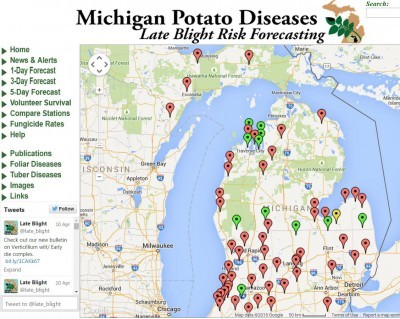The Late Bight Risk Forecasting website, used for estimating potential survival of potato volunteers in Michigan, is now available for 2015 risk estimation. Epidemics of potato late blight are initiated from mycelium of Phytophthora infestans, which survives between successive growing seasons by overwintering in infected potato tubers intended for seed, as volunteer tubers left in fields at harvest, or within discarded cull and rock piles. It is difficult to estimate the probability that infected potato stems will emerge from an infected tuber, and several factors can influence the fate of the infected tuber, temperature being one of the most important.

Over the past three years of monitoring, it has been recorded that overwinter soil thermal conditions have been conducive for the survival of volunteer potatoes and are acting as potential sources of inoculum in the spring. In each year since the monitoring was established, there have been reports of volunteers each year in areas even where no and low survival was predicted.
What is volunteer survival?
Potatoes left in the field at harvest are known as volunteer potatoes. In areas where winter soil temperatures are not cold enough to kill tubers left in the field, they can survive the winter and become a serious weed problem the following spring. In addition, volunteer potatoes that survive the winter can harbor pests and diseases.
Epidemics of potato late blight can be initiated from mycelium of Phytophthora infestans that survives over winter in infected volunteer potatoes. Studies at Michigan State University have shown that tubers of most cultivars appear to break down after exposure to temperatures below 27 degrees Fahrenheit for about one day.
A model has been developed on the Late Bight Risk Forecasting website that predicts the likelihood of tuber survival over the winter based on soil temperatures at 2 and 4 inches between Nov. 1 and March 31. These predictions can be found by clicking on the colored pins located on the map of the homepage.otato late blight can be initiated from mycelium of Phytophthora infestans that survives over winter in infected volunteer potatoes. Studies at Michigan State University have shown that tubers of most cultivars appear to break down after exposure to temperatures below 27 degrees Fahrenheit for about one day.
If tubers were exposed to temperatures below 27 degrees for more than 120 hours between Nov. 1 and March 31 at 4- and 2-inch depths, then the risk of tuber survival is considered low (indicated by a green marker pin).
If tubers were exposed to temperatures below 27 degrees for less than 120 hours at a 4-inch depth and greater than 120 hours at a 2-inch depth, then there is a moderate risk of tuber survival (indicated by a yellow marker pin).
If tubers were exposed to temperatures below 27 degrees for less than 120 hours at a 4-inch depth and less than 120 hours at a 2-inch depth, then there is a high risk of tuber survival (indicated by an orange marker pin).
Most regions experienced soil thermal conditions that placed them in the high-risk category for volunteer survival despite the severe 2014-15 winter. Northport (Leelanau County), Eastport (Antrium County), Kewadin (Antrium County), Elk Rapids (Antrium County), Traverse City (Grand Traverse County), Fremont (Newaygo County), Mecosta (Mecosta County), Ithaca (Gratiot County), Richville (Saginaw County), Lawton (Van Buren County) and Sandusky (Sanilac County) were at low risk, and Fairgrove (Tuscola County) had moderate risk of potato volunteer survival.
This situation should alert potato growers to the high risk of potato volunteers surviving the winter. Michigan State University Extension advises all growers, therefore, to be implementing their integrated pest management scouting programs early in 2015 and considering volunteer elimination programs in adjacent non-potato crops if herbicides are registered.
Source: Michigan State University Extension